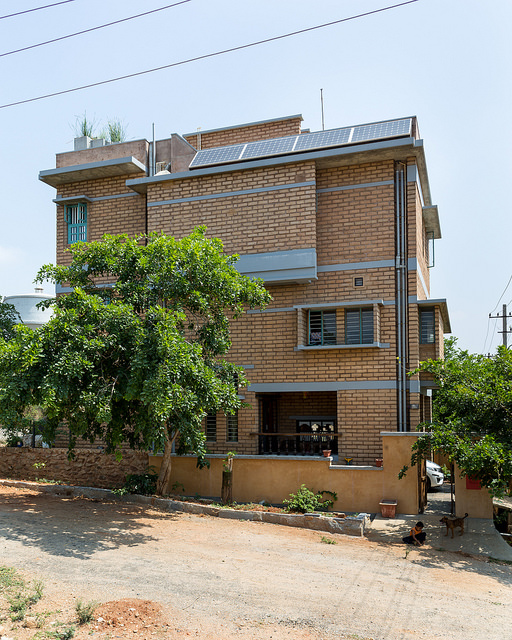Name of the project: Hamsadhwani, House for the Bhat’s
Location: Kanakapura Road, Bangalore, India
Year of completion: 2016
Design Team: Sharath Nayak, Karishma Susan Kurian, Ramya Ramesh, Sanjana Mada, Ambika Malhotra
Consultants: Mahijaa Structural Consultants
Contractors: Surendra. M.B, Naveen Kumar. K.B
Photo Credits: Vivek Muthuramalingam
The Bhat house is built on a 30’x50’ corner site. The site had it’s peculiarities – a sharp slope of about 4’ along the length of the site and a rocky outcrop in the North-western corner. The outcrop occupied about a quarter of the site. Both us and the client liked the rocks and decided on retaining the rocks with the intent of developing a boulder garden around it.
“A personal timeless abode with a character of its own that grows on you over time like AR Rehman’s music” was what the building brief said.
The Bhat family is a young couple with two toddlers. Prashanth’s mother also lives with them. The family wanted a house where the different spaces overlook one another, such that the rooms do not end up being silos but the house needed to provide space for quiet and solitude when one sought such moments.
The house also had to cater for the needs of the inhabitants of different ages and past times. Prashanth’s mother liked to garden, Prashanth spends his spare time cycling, in DIY and painting and is interested in banking and finance. Prathibha is passionate about singing and is interested in semi-classical music.
The decision to retain the rocks meant a smaller footprint would be available for the house to be built on. So, it was decided to move the main living areas one level higher with the mothers bedroom a few more steps higher. On the ground, is the car garage with Prashanth’s DIY space behind it, overlooking the boulder garden. The house itself is reached by climbing a short flight of steps to a sitout space where the family spends it’s evenings. One enters the house beyond and passes by Prashanth’s study space from where a flight of stairs leads to the level of the living spaces. The staircase is like an internal street and is designed such that it serves as a light well to the common areas of the house and also serves to provide visual connect between various rooms through windows provided inside the house. Most of the rooms over look the boulder garden. The constraint of space dictated that seats in the living were inbuilt into the windows thus negating the need for any furniture in the living room.
The Bhat family are from Coastal Karnataka and procured doors and windows from dismantled houses from that region which were positioned in various locations in the new house- a nostalgic link to their roots.
The aesthetic preferred was one of ruggedness over neat lines and finishes. The entire house is built with walls of handmade- stabilized adobe bricks that were made on site and precast arch panels was the choice for most roofs. To bring color into the house and to break the monotony of the adobe walls, brightly colored Athangudi tiles are used in the common areas in addition to bright color of paint for the windows. The bedrooms are having terracotta floors, chosen for the comfort they provide.
The house harvests all the rainwater that falls on its roof. A portion of the roof has been kept aside to treat the grey water that the house produces. This treated water is then used for flushing and gardening. The site has a good South exposure and that is used to install solar panels which powers most of the electrical needs of the house.
More images:
Drawings:







































